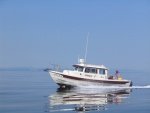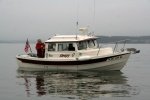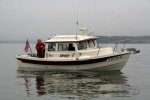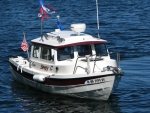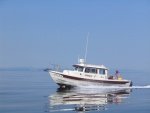Hey Tom, You looked great.
I went to a meeting tonight about fish farm / open water fish pens put on by a coordinated effort of three organizations: Puget SoundKeeper’s, Washington Wild Fish Conservancy, and Sierra Club. It was very enlightening.
The main speakers were Chris Wilke, from Puget Soundkeepers who gave a family album of the PNW salmon, which for me was very enlightening since I am not a fisherman. He talked about the general 5 species, and then the additional 3, Char, Steelhead and Rainbow (I think was the other one). The last three are related, but depend on whether they go to the salt water or not as to what they are.
The second main speaker was, Kurt Beardslee, Director of Wild Fish Conservancy. He is a Researcher and Director with 28 years of research in Puget Sound and on salmon environments in the PNW, with 5 years associated with Alexandra Morton working in BC waters. He was the first scientist, and first boat at the Cypress Island pens after the pen collapse. He was also the scientist that warned the DFW about a pending IHN virus outbreak in the fish pens at the South end of Bainbridge Island about 10 years ago.
He has been collecting samples of the escaped Atlantic Salmon for dissection and testing for disease and anomalies. He reported disfigured fish, internal tumor like growths, fatty hearts, and soft (easily torn) flesh, and empty stomachs. One of the tests they are doing is for viruses and there are no results for those tests back yet. His comment, “Not something I would eat.”
For anyone interested, there is going to be a flotilla meeting on the water at the south end of Bainbridge Island, on Sept 16, between 2 to 4 PM, (bring your vessel – kayak to research ship) and Alexandra Morton will be in attendance on a 70 foot research vessel. The purpose of the flotilla is to draw attention to the fish pen farms there, to deliver the signed petitions (See this site:
https://www.oursound-oursalmon.org/#take-action
) to the Washington State Governor at his home on Bainbridge Island, and to attract media attention to the fact that the Governor supports the fish pens being in the water of Washington State, The only state on the West coast that has allowed open water fish farm pens in out waters.
I’m not a fisherman but I am a promoter for wildlife, clean water, and sound ecological practices, (and I like using my boat for "community service" projects) And, there is always time to learn.
Harvey
SleepyC:moon
